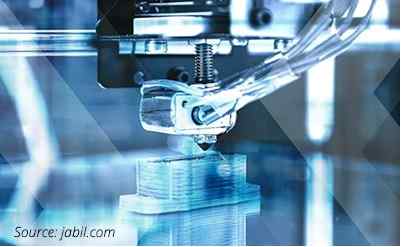A Revolution In Manufacturing Industry : 3D Printing or Additive Manufacturing

To eliminate the need for expensive manufacturing tools, and its energy-efficient features, additive manufacturing or 3D printing is becoming increasingly integrated into various industries. The main reason behind this could be its ability to produce items of complex shape and geometry. Moreover, 3D printing can produce different objects without creating specific tooling or even using several tools. And that's how 3D printing works in reducing the industrial expenses and also increase the flexibility in the production flow. In this way, the additive manufacturing enables many people to produce and sell their creations by skipping distribution networks and traditional edition.
In one line you can say, 3D printing gives everyone the power to manufacture objects only when they are desired or needed.
What is 3D printing or Additive Manufacturing?
Additive manufacturing or 3D printing has brought a revolution in the manufacturing industry. As they are synonyms for the same process, 3D printing or additive manufacturing refer to the process of building parts by joining material layer by layer from a computer aided design (CAD) file. Now, you might be wondering why 3D printing is called additive manufacturing. As the creation of a 3D printed object is achieved using additive processes, hence the name. An object is created by laying down successive layers of material until the object is created in an additive process.
When you create an object by traditional means, the material is often removed through carving, machining, milling, shaping or any other means. In contrast, we use additive manufacturing to get more precise shapes. After the raw materials are either extracted from minerals or produced from natural or basic substances, the cycle of manufacturing process starts immediately.
| Also Read: Revolutionizing Production: The Rise of Additive Manufacturing |
The amazing capabilities of additive manufacturing have transformed production majorly in five industries i.e. aerospace, consumer products, energy, medical and transportation, in particular. If implemented properly, the additive manufacturing can significantly reduce material waste, amount of distinct parts needed for an assembly, and amount of production steps. Single step manufacture, customization, ease of access, speed, complexity and design freedom are the main advantages of 3D printing.
| Also read: A Comprehensive Guide to Rapid Prototyping Techniques |
 Processes Involved In Additive Manufacturing Processes are :
Processes Involved In Additive Manufacturing Processes are :
• Material Extrusion
• Directed Energy Deposition
• Material Jetting
• Binder Jetting
• Sheet Lamination
• Vat Polymerization
• Powder Bed Fusion
| Also Read: Revolutionizing Production: The Rise of Additive Manufacturing |
How 3D printing Can Change The Future Of Development?
With the potential of 3D printers in homes in the near future, the costs of 3D printing are still decreasing. And, the much raised question for everyone would be does 3D printing save money? The answer to this would be yes. It saves businesses time and money. 3D printers also allows testing of new product designs by decreasing production time and costs. With essential products, it could help connect difficult-to-reach and marginalized populations, as this technology spreads. It has the potential to modernize our societies and change the development sector. But, we need to make sure that this emerging technology is in the correct hands of stakeholders and development practitioners around the world.
| Also Read: 3D Printing Revolution: Transforming Manufacturing Processes |
Based on different industry sectors, 3D printing has various emerging and near-term future uses in automotive and industrial manufacturing, retail, aerospace, pharma/healthcare. Also, it has a very bright future in engineering where it can be used in rapid prototyping, reduced lead times, and also mass production.
Here are a list of few 3D printer manufacturers:
1. Hewlett-Packard (HP), US
2. Proto Labs, US
3. 3D Systems, US
4. Stratasys, Israel
5. Materialise, Belgium
6. SLM Solutions Group, Germany
7. Nano Dimension, Israel
8. ExOne, US
Conclusion: 3D printers are nothing but a type of robot that is able to print 3D models using successive layers of material.











